2021 Santa Cruz Nomad
Test Location: Gunnison-Crested Butte Valley, Colorado; Sedona, AZ; Western WA; and others
Duration of Test: 3 months
Size Tested: Large
Geometry: See Below
Build Overview (as tested):
- Drivetrain: SRAM X01
- Brakes: SRAM Code RSC
- Fork: Fox 38 Factory
- Rear Shock: Fox Float X2 Factory
- Wheels: Santa Cruz Reserve 30
Wheel Size: 27.5”
Travel: 170 mm rear/ 170 mm front
Frame Material: Carbon Fiber
Build Overview: See Below
Blister’s Measured Weight (as tested; w/o pedals): 32.4 lbs (14.7 kg)
Price:
- Carbon CC frame with Fox Float X2 or DHX 2 Factory: $3,749
- Complete bikes: $4,949– $9,599 (see below for details)
Reviewer: 6′, 165 lbs (183 cm, 74.8 kg)
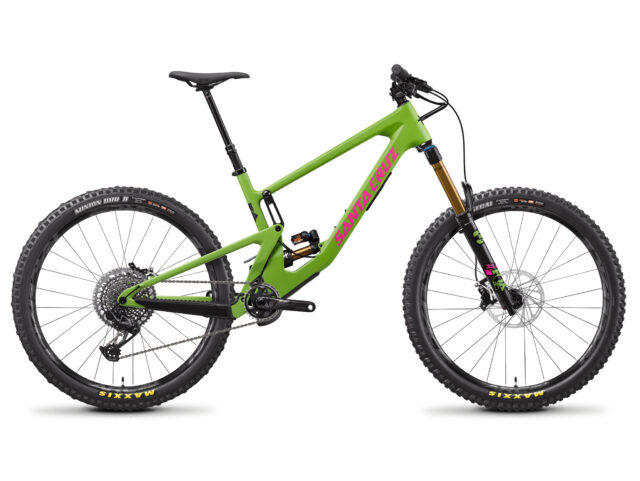
Intro
The Nomad has been in Santa Cruz’s lineup since 2005, and it is now in its fifth version. As with the prior-generation bike, the Nomad is still a 170 mm travel, 27.5’’ wheeled bike, that Santa Cruz describes as being up for a bit of anything — a one dimensional, park-only sled this is not.
We’ve been spending a lot of time on the new Nomad, and we talked about it a bit on Episode 59 of Bikes and Big Ideas. And now that we’ve spent a lot more time on it, you can read our full review below.
The Frame
The new Nomad V5 is visually extremely similar to the outgoing V4. The overall lines of the frame are nearly identical, and both share Santa Cruz’s newer, lower-link-driven VPP suspension layout with 170 mm of rear-wheel travel. The 27.5’’ wheels carry over as well — in a world where 29’’ wheels (and mullet 29″ / 27.5″ setups) seem to be taking over, we’re really excited to see Santa Cruz keeping some options around for fans of smaller wheels.
Unlike the V4 Nomad though, the V5 Nomad is currently available in carbon only — the aluminum version is no more. As per usual for Santa Cruz, there are two versions of the carbon frame. The more basic Carbon C frame is offered on the lower-level builds, while the Carbon CC is available as a frame only or on the top-tier X01 build. Santa Cruz says the Carbon CC frame cuts about 280 g by way of more advanced carbon layup, without a loss of stiffness or strength.
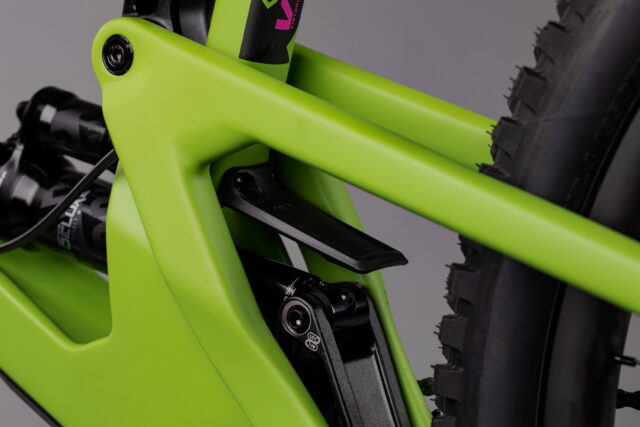
The Nomad V5 gets most of the standard features you’d expect from a modern, high-end Enduro bike. There’s a rubber guard on the chainstay, as well as additional frame protection on the downtube just forward of the bottom bracket and behind the headtube to protect the frame when shuttling over a tailgate. A bolt-on mini fender protects the rear shock from gunk thrown off the rear wheel. The cable routing is fully internal, the bottom bracket shell is threaded, the derailleur hanger is a SRAM UDH, and the brake mount is set up for a 180 mm rotor. A large water bottle fits inside the front triangle on all sizes as well. ISCG-05 chainguide tabs are provided, and a chainguide is provided on all of the complete builds.
Mullet bikes are growing in popularity (and Santa Cruz offers several, such as the new Bronson), but they make a point of discouraging riders from attempting such a setup on the Nomad. Per their FAQ section, “we don’t recommend this [a mullet setup]. If you were deadset on doing it you’d be best off using a 150 mm travel 29’’ fork, but that would mean unbalanced suspension feel.” There is a flip chip to toggle between two different geometry settings (more on that below) but it makes a subtle change and isn’t intended to make the Nomad a viable mullet candidate.
As with all of their current models, Santa Cruz offers a lifetime warranty and crash replacement support on the Nomad. You can also check out our 2021 Santa Cruz / Juliana Brand Guide, for more info on Santa Cruz and their full lineup.
The Builds
Santa Cruz offers the Nomad as a frameset with your choice of a Fox Float X2 or DHX2 shock, or as one of four complete builds, plus options for air or coil shocks and a carbon wheel upgrade on certain models. Here’s a breakdown of all the currently available builds for the new Nomad:
Nomad Carbon CC Frame with Fox Float X2 or DHX2 Factory: $3,749
Nomad R Carbon C: $4,949
- Drivetrain: SRAM NX Eagle
- Brakes: SRAM Guide RE
- Fork: RockShox ZEB
- Shock: RockShox Super Deluxe Select
- Wheels: WTB ST i30 with SRAM MTH hubs
- Dropper Post: SDG Tellis
Nomad S Carbon C: $6,049
- Drivetrain: SRAM GX Eagle
- Brakes: SRAM Code R
- Fork: Fox 38 Performance
- Shock: RockShox Super Deluxe Select+
- Wheels: RaceFace AR 30 with DT Swiss 370 Hubs
- Dropper Post: RockShox Reverb
Nomad XT Air Carbon C: $6,849
- Drivetrain: Shimano XT
- Brakes: Shimano XT 4 Piston
- Fork: Fox 38 Performance Elite
- Shock: RockShox Super Deluxe Select+
- Wheels: RaceFace AR 30 with DT Swiss 350 Hubs
- $8,149 with Reserve 30 Carbon wheel upgrade
- Dropper Post: RockShox Reverb
Nomad XT Coil Carbon C: $6,849
- Drivetrain: Shimano XT
- Brakes: Shimano XT 4 Piston
- Fork: Fox 38 Performance Elite
- Shock: RockShox Super Deluxe Coil Select+
- Wheels: RaceFace AR 30 with DT Swiss 350 Hubs
- $8,149 with Reserve 30 Carbon wheel upgrade
- Dropper Post: RockShox Reverb
Nomad X01 Air Carbon CC: $8,249
- Drivetrain: SRAM X01
- Brakes: SRAM Code RSC
- Fork: Fox 38 Factory
- Shock: Fox Float X2 Factory
- Wheels: RaceFace AR 30 with DT Swiss 350 Hubs
- $9,599 with Reserve 30 Carbon wheel upgrade (tested)
- Dropper Post: RockShox Reverb
Nomad X01 Coil Carbon CC: $8,249
- Drivetrain: SRAM X01
- Brakes: SRAM Code RSC
- Fork: Fox 38 Factory
- Shock: Fox DHX2 Factory
- Wheels: RaceFace AR 30 with DT Swiss 350 Hubs
- $9,599 with Reserve 30 Carbon wheel upgrade
- Dropper Post: RockShox Reverb
The XT and X01 coil versions are identical to the air ones, apart from the rear shock and the inclusion of beefier DoubleDown tire casings on the coil options, vs. the Exo+ casings on the Air versions. All of the builds get big brakes (200 mm rotors on both ends for all the SRAM builds, 203 mm front / 180 mm rear for the Shimano ones), 38mm-stanchioned forks, and chainguides. Our top-spec X01 Air test bike comes in at a very respectable 32.4 lbs (14.7 kg) in a size Large, but overall these are very stout builds, meant to hold up to serious abuse, rather than focusing on light weight.
There’s a big range in the build levels on offer, but it’s a bit of a bummer that the aluminum Nomad is no longer available. The most basic build is still far from cheap, at $4,949, and it’d be nice to have the more affordable aluminum frame option still around.
Fit and Geometry
The Nomad V5 got slightly longer and slacker in its update from the V4 bike, but those changes are comparatively subtle, especially these days. The most dramatic differences are in the effective seat tube angle, which went from 74.5° to roughly 78° (varies slightly by size; both listed in the high geometry position), and the loss of the XS size. The new Nomad now comes in four sizes, from Small through XL, with reach numbers ranging from 425 to 500 mm in 25 mm increments. The headtube angle is now 64° across the board in the high position, and drops by a modest 0.3° in the low one.
The Nomad also receives size-specific chainstay lengths, an increasingly common move that we at Blister think makes a lot of sense. The chainstays on the V4 bike were quite short at 430 mm in all sizes; on the V5 they range from 425 mm to 440 mm, in 5 mm increments between sizes. That’s still not super long, but does mean that the Large and XL frames have a bit longer stays than the prior model. All of that adds up to a long-ish, but not massive 1257 mm wheelbase on our size Large test bike (low position), which makes a lot of sense for a bike that Santa Cruz definitely intends to be versatile and somewhat playful. For reference, here’s the full geometry chart for the V5 Nomad:
The Nomad is by no means some short, steep bike, but it’s not as aggressive as some newer bikes in a similar travel range — notably the Transition Patrol and Spire, for example. It seems like the Nomad’s geometry numbers should make for a bike that’s quite capable and fairly forgiving, but also not one that looks like it is only at home going warp speed in big terrain. Santa Cruz talks about the Nomad as a bike that’s meant to be burly, but still fairly versatile, rather than being some ultra-focused Enduro race bike. As they put it: “when peeling your bike out of the van at a new spot your only question should be ‘is this a full face or a half lid kinda ride?’”
FULL REVIEW
I’ve spent a lot more time on the Nomad since publishing our Flash Review (which Blister Members can check out here) and have found it to be a super fun, surprisingly versatile bike. And while 29’’ wheels are seemingly taking over the world these days, the Nomad makes a very convincing case that 27.5’’ ones still have their place in the mountain bike landscape too.
Climbing
With 170 mm of travel at both ends, nobody should expect the Nomad to be a rocketship on the way up, but its overall pedalling performance is very respectable for this sort of bike. The relatively low weight (32.4 lbs / 14.7 kg) of the top-spec Carbon CC X01 Air build I’ve been riding certainly doesn’t hurt, but the Nomad also pedals reasonably efficiently and strikes a nice balance between that efficiency and still maintaining compliance and traction under pedalling. The Nomad doesn’t go all in on efficiency like some other bikes with similar travel (notably the Privateer 161) but — as will be a common theme throughout this review — strikes a middle ground between the two ends of the spectrum.
That balance, and the not-totally-over-the-top geometry of the Nomad also makes for a bike that’s uncommonly adept at technical climbing, for something with this much suspension travel. Ultra-long wheelbases are great for high speed stability, but tend to make for much more ponderous handling at low speeds, which can be a liability when navigating tight, technical climbing. At 1,257 mm for the size Large in the low geometry position, the wheelbase on the Nomad certainly isn’t short, but it’s not as long as a lot of other bikes with similar amounts of travel, such as the Privateer 161 and the Guerrilla Gravity Gnarvana, for example. The Nomad definitely doesn’t put down power as efficiently as a much shorter-travel bike, but when the going gets weird it does a good job of feeling maneuverable and easy to muscle around and over awkward sections of climbs. The only bike in this travel range that I’ve ridden recently that feels at least close to matching the Nomad in tight, awkward climbing prowess is the Rocky Mountain Altitude, but I’d still give the edge to the Nomad, mostly because it puts down power just a touch more efficiently. Shorter-travel bikes will generally be a better option for riders specifically looking to emphasize technical climbing ability, but for the class of bike it occupies, the Nomad is really excellent.
Descending
Santa Cruz talks a lot about the Nomad being the sort of bike that you could take on a road trip and do everything from longer days of pedalling to bike park laps, and they’re right to emphasize the versatility of the Nomad — particularly for a 170mm-travel bike.
A lot of long-travel Enduro bikes feel very “game on” and want a huge amount of speed and aggression to come alive and be fun; the Nomad is not one of them. While it’s still fairly stable and composed at speed, the thing that stands out the most about the Nomad is how nimble and playful it is — for a bike that’s also this forgiving and capable.
To be super clear, that “also” is crucial. The Nomad is still a fairly long, fairly slack bike with a whole lot of suspension travel, and there are many more nimble, poppier-feeling bikes out there BUT almost all of them have much less suspension travel and aren’t as stable when the going gets rough. It’s not that the Nomad is somehow immune from the compromises that are inherent to any particular aspect of bike design; rather, Santa Cruz has done an outstanding job of balancing all the variables and coming up with a recipe that can do a little bit of everything, rather than focusing on excelling at any one specific facet of performance. That’s an approach that’s more common in mid-travel Trail bikes than long-travel Enduro ones, but in the case of the Nomad, it makes for a bike that hides its 170 mm of travel remarkably well when the terrain might not call for quite so much suspension.
And speaking of suspension, the Nomad’s is excellent. While it shares the lower-link-driven VPP layout of its 29er stablemate, the Megatower (and nearly all of Santa Cruz’s current bikes), the Nomad feels substantially more plush and compliant than the Megatower, despite only having 10 mm more travel. There’s a good amount of support and pop on offer, too — they don’t publish a leverage curve for the new Nomad, but Santa Cruz say it’s both straighter and more progressive than the prior model, and that certainly feels right on the trail. The suspension performance is smooth and consistent, without the telltale signs of the weird digressive-to-progressive leverage curve from Nomads of old, and the tune on the Float X2 Factory rear shock feels very well chosen for the bike’s design and intentions.
Where the Nomad feels most at home is on descents with a bit of pitch to let the bike run, but with the rider looking for side hits to pop off, berms to square off, and generally take a more playful approach instead of turning the aggression up to eleven and trying to go absolutely as fast as possible. The Nomad is an outstanding jumping bike, especially on more natural / less sculpted features, and is a blast if you’re inclined to seek out as many places to get airborne as possible as you make your way down the trail. It’s a great park bike that can still be happily pedaled to the top, but because of its relative nimbleness, is also relatively engaging when the speeds aren’t super high and the trail not terribly steep.
All that said, the biggest limitation to the Nomad’s versatility as a Trail bike is that 170 mm of suspension travel. On flatter trails in particular, where you’re trying to pump through features to build speed, all that squish is a hindrance when compared to something with much less travel. If you’re mostly riding flatter, flowy trails, something a bit shorter travel is likely a better option. But if you’re looking for a bike that can handle routine bike park or shuttle laps, while also not feeling out of place on an all-day trail ride, it’s a really great choice. And the more bike park and shuttle action it’ll see, the more the extra squish of the Nomad will be a benefit rather than a limitation.
Warranty
On all of their current frames — including the Nomad — Santa Cruz offers a lifetime warranty to the original owner. And that lifetime warranty also applies to their Reserve carbon wheels that came on our test bike.
Unfortunately, I had cause to check out that wheel warranty process. In short, I put a significant crack in the rear rim with a square-edged rock strike (which also resulted in a pinch flat). The rim held on for several more rides with a tube installed, but the crack was clearly spreading, and the wheel would need to be replaced sooner rather than later.
The warranty process is relatively straightforward, though in my case, it did require removing the tire and rim tape to look up the rim serial number, which is on a label inside the rim channel. A secondary sticker with the serial number is apparently included on the outside of the rims when new, but those had been removed by the time we got the Nomad. Santa Cruz has a form to register your wheels at the time of purchase, and while that’s not required to submit a warranty claim, it will streamline the process by having all your information saved ahead of time.
Submitting a warranty claim just requires filling out an online form with the rim serial number, proof of purchase, a photo of the damage, and basic contact information.
In my case, after a couple of follow-up emails and some back and forth, I had a wheel in hand about 2.5 weeks after submitting the claim. Santa Cruz says that many of their more common build combinations should normally ship the next day, and less common ones within a week. I know a couple of people who have had very quick turnaround times on wheel warranties from Santa Cruz before, which backs up Santa Cruz’s claim that my experience was slower than normal.
Who’s It For?
The Nomad wouldn’t be my first choice for a hyper-focused Enduro race bike, but precisely for that reason, I think it’s a great choice for a bunch of people. Riders looking to chase outright speed at every opportunity might be better off with something else. But more focused, race-oriented bikes can’t match the Nomad in terms of playfulness and general fun factor when they’re not being ridden as fast as possible.
A lot of ~170mm-travel Enduro bikes these days feel like mini-DH sleds and really only work when pointed down something steep and rowdy. The Nomad pulls off the rare trick of being a fairly versatile Trail bike, while also feeling thoroughly modern and capable. With 170 mm of travel at both ends, it’s still a bike that makes sense for fairly descending-oriented riders who ride the terrain to put such a bike to work. But if you’ve felt like the modern crop of Enduro race bikes are a bit lifeless and boring except when white-knuckling down a race track, the Nomad could be the bike for you.
Bottom Line
The Santa Cruz Nomad is a super fun, surprisingly versatile bike that just so happens to have a whole lot of suspension travel and downhill capability, too. It’s a bike that’ll appeal more to playful riders looking to have fun out on the trail than the hardcore Enduro race set — but there are a whole lot more riders in that first group than the latter.
The fifth generation of the Nomad is an outstanding example of what a modern 27.5’’ bike can be, and a welcome reminder that smaller wheels still have a place in the world.




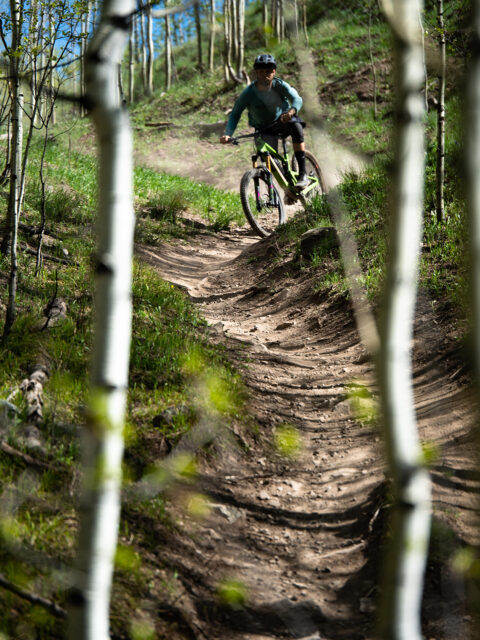
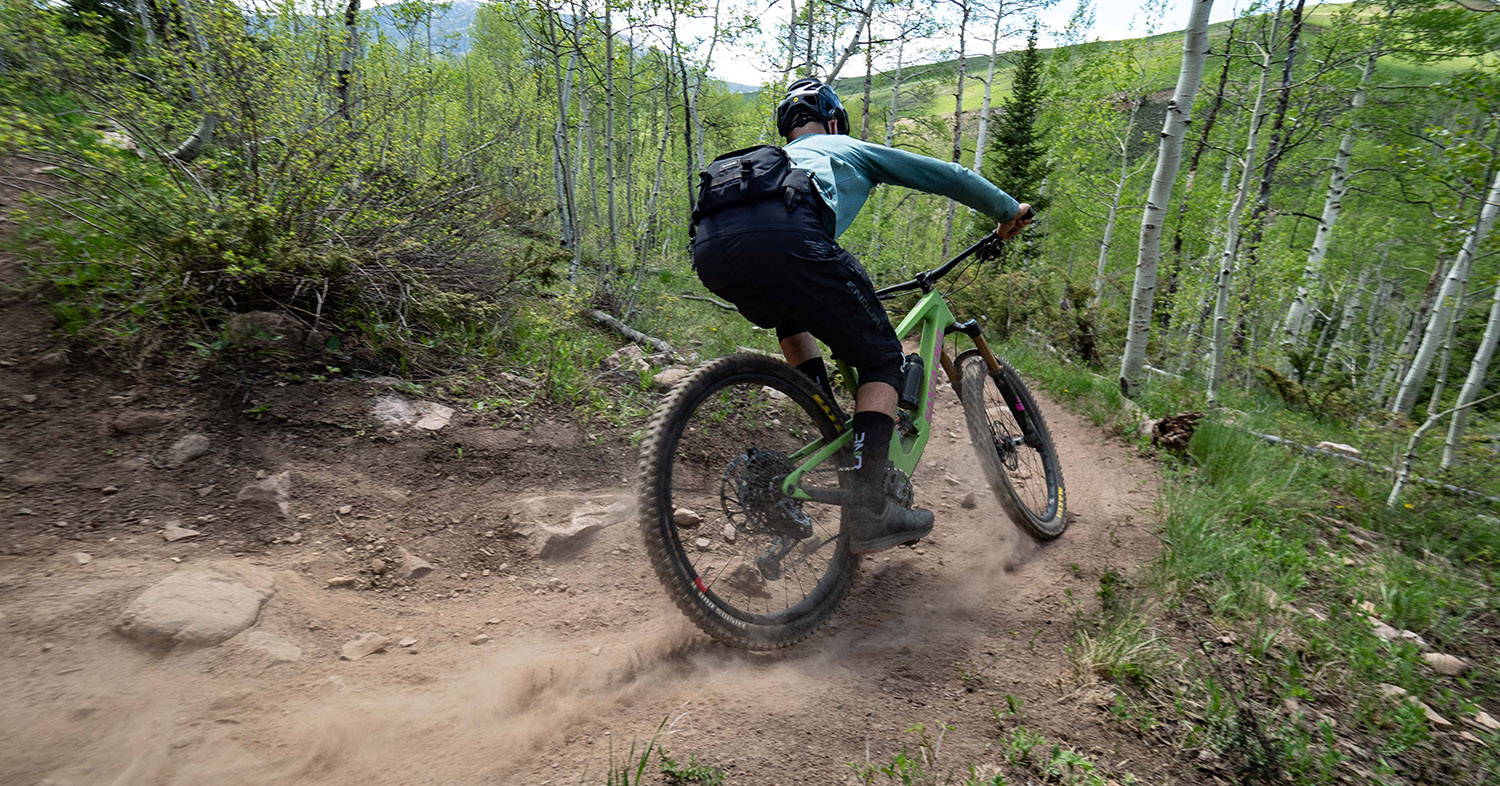
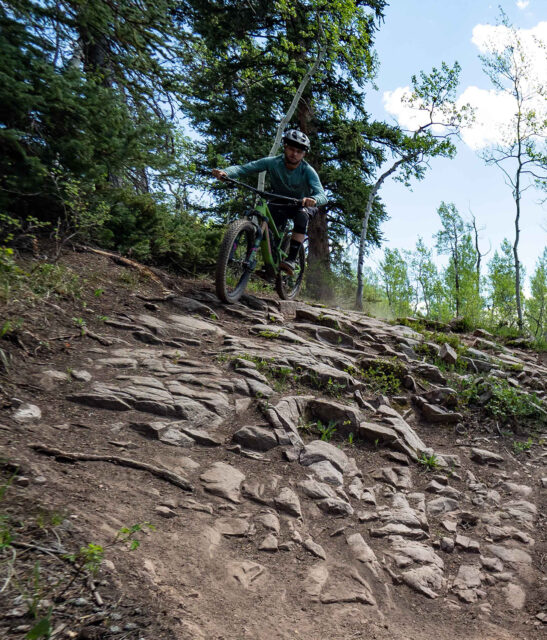
Sexy
Possibly too much bike for most people?
Would be curious how this stacks up to your guys’ experience on the Revel Rail. Seems like a pretty direct comparison.
Bump?